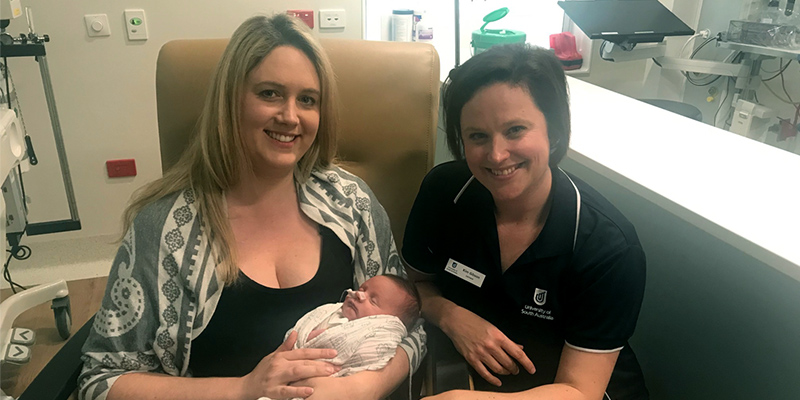Research breakthrough to safely monitor pre-term babies
By Candy Gibson
 RESEARCH UniSA clinical care specialist Kim Gibson pictured with mum Sarah Sheil and her premature baby Toby at Flinders Neonatal Care Unit.
RESEARCH UniSA clinical care specialist Kim Gibson pictured with mum Sarah Sheil and her premature baby Toby at Flinders Neonatal Care Unit.UniSA researchers have successfully trialled new computer vision technology to safely monitor the heart and respiratory rates of premature babies in neonatal units.
In a study led by UniSA neonatal critical care specialist Kim Gibson and engineer Professor Javaan Chahl, the team has demonstrated a new non-contact way to monitor pre-term infants in intensive care.
The infants were filmed using high-resolution cameras at close range and their vital physiological data extracted using advanced signal processing techniques that can detect subtle colour changes and movement not visible to the human eye.
“Our computer vision system captures subtle signals in a pre-term baby, such as invisible skin colour variations that can be amplified to measure cardiac activity,” Gibson says. “We can also apply algorithms to magnify movement to give nursing staff a clear picture of what is going on with pre-term infants.”
The technology has been successfully trialled at Flinders Medical Centre Neonatal Unit, monitoring 10 premature babies.
The pre-term infants were selected as they are prone to episodes of bradycardia (slow heart rate) and apnea (when breathing stops) – conditions which are difficult to monitor without the use of an electrocardiogram which relies on expensive, adhesive electrodes that can damage infants’ fragile skin and leave them vulnerable to infection.
“An unexpected finding was that our system was able to accurately detect apnea when the ECG monitor did not,” Gibson says.
She says further research is needed but preliminary results show that the non-contact system could help monitor the health of pre-term babies, particularly when resources are scarce, and the risk of infection is high.
Gibson is the lead author of a paper, “Non-contact heart and respiratory rate monitoring of preterm infants based on a computer vision system” published in Pediatric Research. Their co-authors are UniSA researchers Prof Adrian Esterman, Prof Mary Steen, Julie Fleet and Jasmine Huynh; Scott Morris from Flinders University and Ali Al-Naji from the Baghdad Middle Technical University.
Other Stories
- BOSS result for UniSA's MBA
- Super-powered immune cells – leading the next cancer breakthrough
- It’s time to end Australia’s culture of workplace bullying
- Personal approach to mental health wins Three Minute Thesis final
- From the Vice Chancellor
- Achievements and Announcements
- Research breakthrough to safely monitor pre-term babies
- $3.9m for research into chronic pain, prenatal genetic testing and heart health
- UniSA opens free tax clinic
- Depression breakthrough: ‘Black Dog’ blamed for major diseases
- Women executives need to work an extra 64 days a year to catch up to men
- UniSA to offer Speech Pathology in 2020
- What works in the workplace?
- UniSA collaboration for a double-barrelled PhD to advance industry expertise in human factors and engineering
- Australians not ‘walking the talk’ when it comes to the environment
- The latest books from UniSA researchers
- Sleeping rough, Ben Folds and social activism




